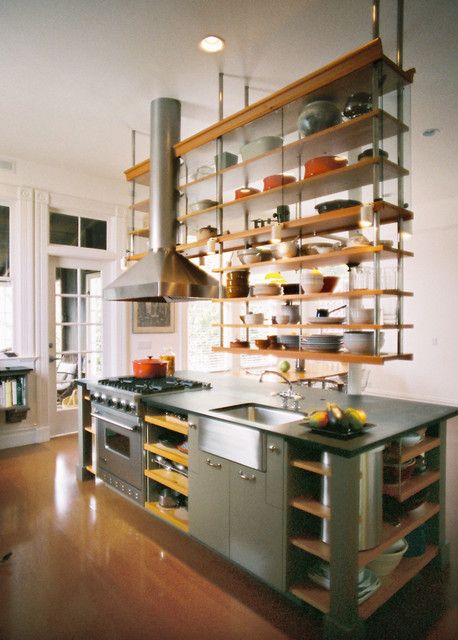Shelves are a great way to store items and also display items you have collected over the years. Enjoy our collection of shelving types and inspiration.
1. Fixed Bracket Type Shelving Systems
 |
| Source |
Fixed bracket type shelves are made
of individual brackets that can be used as stand-alone shelving systems or in
combination with additional brackets to form a multi-unit shelving system.
Fixed brackets are available in metal and wood, and are attached, or hinged,
directly to a wall or a case. They are supported by plastic or metal shelf pins
that range in size and thicknesses. Wood brackets are available in a wide range
of decorative styles and are extensively used in home interiors. Bracket
shelving systems are also called suspension shelving.
2. Built-in Shelving Systems
Built-in shelving systems are among
the simplest of all shelving units. These are structures that are fitted within
nooks and spaces of a home. The simplest type of built-in shelving system is a
single plank of wood fixed horizontally over an opening in a wall. Built-in
shelving systems can be installed virtually anywhere in a home: above or below
wall cabinets, above foundation walls and even beside a fireplace. They can be
assembled and fitted on-site or constructed off-site, typically in a workshop,
and installed once completed. Built-in shelving systems are an effective and
flexible way to maximize unused and awkward spots.
3. Floating Shelving Systems
 |
| Source |
 |
| Source |
Floating shelving systems are a
phenomenal way to visibly display items. Unlike fixed bracket units, which are
attached by visible pins and nails, floating shelving systems appear to “float”
over walls, seemingly unattached to hinges or screws. Floating shelves are supported by
internal brackets. They are available in a wide range of colors, designs, sizes
and shapes and make fine interior decorating accessories.
4. Corner Shelving Systems
Corner shelving systems are a clever
way to maximize storage without taking up too much space. They effectively
utilize inaccessible and hard-to-access corners.
Corner shelving systems are available in solid wood, engineered/laminated wood
and plastic and can be customized to fit any location. Corner shelving systems
can be floor-based or wall-hung and are a great solution for displaying and
storing items.
5. Top Hung Storage Shelving Systems
 |
| Source |
Top hung shelving systems are
commonly used in classrooms, storerooms, stores, and in both residential and commercial kitchens. They incorporate metal sections that are
mounted to walls/ceilings and from which shelves and droppers can be hung.
6. Free Standing Shelving Systems

Source

 |
| Source |
 |
| Source |
Free standing shelving systems are ideal for both storage and display purposes. They are portable and can be shifted to virtually any area, provided there is enough space. Freestanding shelving systems are available in a range of sizes, colors, materials and designs.
Our Pick's
Logan, our newest designer on board, has picked this lovely shelving system which is a great example of a fixed bracket shelf. The simplistic profile of the shelf hardware lends itself to a crisp look that we love. The use of natural elements such as wood, Travertine stone tile, and a neutral color palette all help to ease the edginess of the stark black hardware that would otherwise read as extremely modern. "I find this to be a great example of how to marry modern and rustic styles...something that could easily be translated into the regional design aesthetic," states Logan.
Another of our designers, Stevi, has elected this beautiful built-in system as her favorite. The built-ins are a very timeless type of system. They have, and especially these in particular, a very purposeful look to them, making them very integrated into the design of the whole room. The built-ins in this home made great use of an otherwise easily wasted space. They have a very traditional feel to them that has been modernized with the white color palette and the combination of brighter colors in the books and surrounding furniture. Stevi elaborates on why she likes the space by saying: "This space is the personal home of my favorite designer and author of the blog Little Green Notebook. I love that her work reads as energetic and traditional but not preppy!"
Vickie, one of our lead designers, chose this rustic built-in, that is nestled in the hall of this relaxed cottage-style home. This built-in makes use of a space that would otherwise go unused. Its casual placement, perpendicular of the door frame, yields prominent horizontal lines that make the entrance into the bedroom all the more powerful, while still maintaining an effortless appeal to it. Vickie states, "I love the homeyness of the space while still providing a useful function. It's intention is to make me want to curl up with a blanket and book right next to it, and it's effect on me is exactly that!"





































